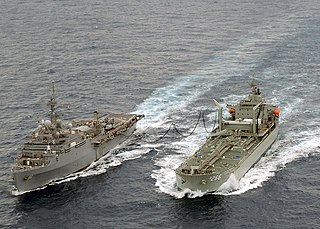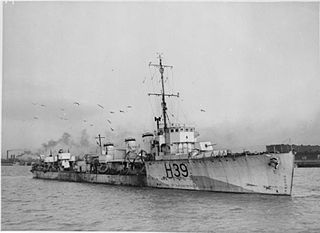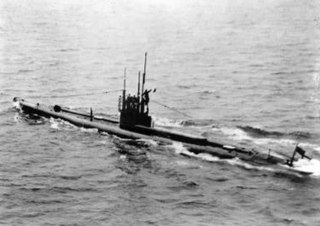
The Royal Navy (RN) is the naval warfare force of the United Kingdom, British Overseas Territories and Crown Dependencies, and a component of His Majesty's Naval Service. Although warships were used by English and Scottish kings from the early medieval period, the first major maritime engagements were fought in the Hundred Years' War against France. The modern Royal Navy traces its origins to the English Navy of the early 16th century; the oldest of the UK's armed services, it is consequently known as the Senior Service.

The MICA is a French anti-air multi-target, all weather, fire-and-forget short to medium-range missile system manufactured by MBDA France. Its name is an abbreviation of Missile d'Interception, de Combat et d'Auto-défense. It is intended for use both by air platforms as individual missiles as well as ground units and ships, which can be equipped with the rapid fire MICA Vertical Launch System. It is fitted with a thrust vector control (TVC) system. It was developed from 1982 onward by Matra. The first trials occurred in 1991, and the missile was commissioned in 1996 to equip the Rafale and Mirage 2000. It is a replacement for both the Super 530 in the interception role and the Magic II in the dogfighting role. MICA-EM and MICA-IR both can fulfill the roles of short-range and medium range BVR air to air missiles.

HMS Euryalus (F15) was a Leander-class frigate of the Royal Navy (RN). Like the rest of the class, Euryalus was named after a figure of mythology. Euryalus was built by Scotts Shipbuilders of Greenock. Euryalus was launched on 6 June 1963, and commissioned on 16 September 1964.
J. Samuel White was a British shipbuilding firm based in Cowes, taking its name from John Samuel White (1838–1915).

The Ikara missile was an Australian ship-launched anti-submarine missile, named after an Australian Aboriginal word for "throwing stick". It launched an acoustic torpedo to a range of 10 nautical miles (19 km), allowing fast-reaction attacks against submarines at ranges that would otherwise require the launching ship to close for attack, placing itself at risk. By flying to a distant target, the engagement time was dramatically shorter than provided by short-range weapons, giving the target less time to respond.
In the Royal Navy and other navies of Europe and the Commonwealth of Nations, ships are identified by pennant number. Historically, naval ships flew a flag that identified a flotilla or type of vessel. For example, the Royal Navy used a red burgee for torpedo boats and a pennant with an H for torpedo boat destroyers. Adding a number to the type-identifying flag uniquely identified each ship.

The River class was a class of 151 frigates launched between 1941 and 1944 for use as anti-submarine convoy escorts in the North Atlantic. The majority served with the Royal Navy and Royal Canadian Navy (RCN), with some serving in the other Allied navies: the Royal Australian Navy (RAN), the Free French Naval Forces, the Royal Netherlands Navy and, post-war, the South African Navy.

HMS Bramham (L51) was a Hunt-class destroyer of the Royal Navy laid down in Alexander Stephen and Sons shipyards Govan, Scotland on 7 April 1941. She was launched on 29 January 1942 and commissioned into the Royal Navy on 16 June 1942. She was named after the Bramham Moor Hunt and has been the only Royal Navy warship to bear the name. She was adopted by the town of Beverley in the East Riding of Yorkshire during the Warship Week savings campaign of 1942.

A replenishment oiler or replenishment tanker is a naval auxiliary ship with fuel tanks and dry cargo holds which can supply both fuel and dry stores during underway replenishment (UNREP) at sea. Many countries have used replenishment oilers.

Ships of the Royal Navy is a naval history reference work by J. J. Colledge (1908–1997); it provides brief entries on all recorded ships in commission in the Royal Navy from the 15th century, giving location of constructions, date of launch, tonnage, specification and fate.

The first R class were a class of 62 destroyers built between 1916 and 1917 for the Royal Navy. They were an improvement, specifically in the area of fuel economy, of the earlier Admiralty M-class destroyers. The most important difference was that the Admiralty R class had two shafts and geared turbines, compared with the three shafts and direct turbines of the Admiralty M class, but in appearance the R class could be distinguished from its predecessors by having the after 4-inch gun mounted in a bandstand. The Admiralty ordered the first two of this class of ships in May 1915. Another seventeen were ordered in July 1915, a further eight in December 1915, and a final twenty-three in March 1916.

Adrias was a Type III Hunt-class destroyer that was originally built for the Royal Navy as HMS Border but never commissioned. Before her completion, she was loaned to the Royal Hellenic Navy on 20 July 1942 and commissioned as Adrias on 5 August 1942 in order to relieve heavy losses of ships sustained by the Royal Hellenic Navy during the German invasion of 1941 and throughout the war. Adrias took her name from the ancient Greek town of Adria in Italy, at the mouth of the Po river, after which the Adriatic Sea is named.

The F-class submarine was built for the Royal Navy as a coastal submarine based on the doubled hulled V-class submarine with very few minor improvements. The only important improvement was the addition of a stern torpedo tube. The F class were ordered as a successor to the E-class submarine, but only three were built out of the ten ordered, the first F1 at Chatham.
Marisat satellites were the first mobile telecommunications satellites and were designed to provide dependable telecommunications for commercial shipping and the U.S. Navy from stable geosynchronous orbital locations over the three major ocean regions. The three Marisat satellites, F1, F2, and F3, were built by Hughes Aircraft Corporation (HAC) for COMSAT Corporation starting in 1973. The satellites were designed to provide maritime telecommunications services in three large ocean areas, the Atlantic Ocean, the Pacific Ocean, and the Indian Ocean, and were located at 72.5° East longitude, 176.5° E, and 345° E in the geosynchronous orbital arc. The three-satellite Marisat system served as the initial INMARSAT constellation.

The Astraea class was an eight ship class of protected cruisers built for the Royal Navy during the 1890s. The ships served on a number of foreign stations during their careers, particularly in the waters of the Indian and Pacific Oceans, and around the Cape of Good Hope. Already obsolete by the outbreak of the First World War, most continued to see service in a variety of roles, though rarely in a front line capacity. By the end of the war the majority were being used as training or depot ships, and they were soon sold out of the service and scrapped. However, one ship, HMS Hermione, was bought by the Marine Society and used as a training ship until 1940.

HMIS Tir was a River-class frigate of the Royal Indian Navy (RIN). She was acquired from the Royal Navy where she served as HMS Bann during World War II. She was commissioned into the RIN in December 1945.

Allal Ben Abdellah (615) is a SIGMA 9813 frigate of the Royal Moroccan Navy. The ship is the last of three SIGMA multi-mission frigates ordered by Morocco from Damen Schelde Naval Shipbuilding, entering service in 2012.














